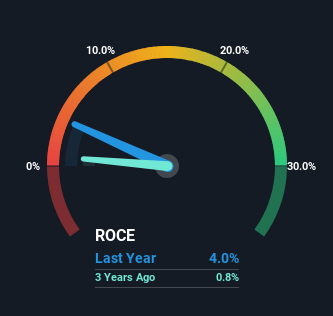Investors Will Want Molson Coors Canada's (TSE:TPX.B) Growth In ROCE To Persist

If we want to find a potential multi-bagger, often there are underlying trends that can provide clues. Typically, we'll want to notice a trend of growing return on capital employed (ROCE) and alongside that, an expanding base of capital employed. Ultimately, this demonstrates that it's a business that is reinvesting profits at increasing rates of return. So when we looked at Molson Coors Canada (TSE:TPX.B) and its trend of ROCE, we really liked what we saw.
Return On Capital Employed (ROCE): What Is It?
For those that aren't sure what ROCE is, it measures the amount of pre-tax profits a company can generate from the capital employed in its business. Analysts use this formula to calculate it for Molson Coors Canada:
Return on Capital Employed = Earnings Before Interest and Tax (EBIT) ÷ (Total Assets - Current Liabilities)
0.04 = US$913m ÷ (US$26b - US$3.3b) (Based on the trailing twelve months to March 2023).
Therefore, Molson Coors Canada has an ROCE of 4.0%. In absolute terms, that's a low return and it also under-performs the Beverage industry average of 15%.
View our latest analysis for Molson Coors Canada

While the past is not representative of the future, it can be helpful to know how a company has performed historically, which is why we have this chart above. If you want to delve into the historical earnings, revenue and cash flow of Molson Coors Canada, check out these free graphs here.
How Are Returns Trending?
Even though ROCE is still low in absolute terms, it's good to see it's heading in the right direction. The data shows that returns on capital have increased substantially over the last five years to 4.0%. The company is effectively making more money per dollar of capital used, and it's worth noting that the amount of capital has increased too, by 123%. So we're very much inspired by what we're seeing at Molson Coors Canada thanks to its ability to profitably reinvest capital.
What We Can Learn From Molson Coors Canada's ROCE
In summary, it's great to see that Molson Coors Canada can compound returns by consistently reinvesting capital at increasing rates of return, because these are some of the key ingredients of those highly sought after multi-baggers. Considering the stock has delivered 9.3% to its stockholders over the last five years, it may be fair to think that investors aren't fully aware of the promising trends yet. So with that in mind, we think the stock deserves further research.
If you want to continue researching Molson Coors Canada, you might be interested to know about the 1 warning sign that our analysis has discovered.
While Molson Coors Canada isn't earning the highest return, check out this free list of companies that are earning high returns on equity with solid balance sheets.
If you're looking to trade Molson Coors Canada, open an account with the lowest-cost platform trusted by professionals, Interactive Brokers.
With clients in over 200 countries and territories, and access to 160 markets, IBKR lets you trade stocks, options, futures, forex, bonds and funds from a single integrated account.
Enjoy no hidden fees, no account minimums, and FX conversion rates as low as 0.03%, far better than what most brokers offer.
Sponsored ContentNew: Manage All Your Stock Portfolios in One Place
We've created the ultimate portfolio companion for stock investors, and it's free.
• Connect an unlimited number of Portfolios and see your total in one currency
• Be alerted to new Warning Signs or Risks via email or mobile
• Track the Fair Value of your stocks
Have feedback on this article? Concerned about the content? Get in touch with us directly. Alternatively, email editorial-team (at) simplywallst.com.
This article by Simply Wall St is general in nature. We provide commentary based on historical data and analyst forecasts only using an unbiased methodology and our articles are not intended to be financial advice. It does not constitute a recommendation to buy or sell any stock, and does not take account of your objectives, or your financial situation. We aim to bring you long-term focused analysis driven by fundamental data. Note that our analysis may not factor in the latest price-sensitive company announcements or qualitative material. Simply Wall St has no position in any stocks mentioned.
About TSX:TPX.B
Molson Coors Canada
Molson Coors Canada Inc. brews, markets, sells, and distributes various beer brands in the Americas, Europe, the Middle East, Africa, and the Asia-Pacific.
Unattractive dividend payer very low.
Similar Companies
Market Insights
Community Narratives



